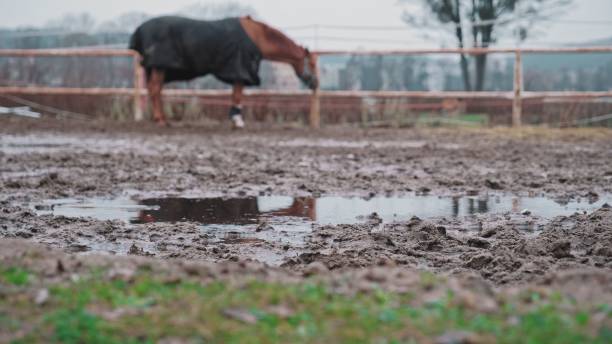It’s easy to forget how important it is to manage our fields. We often see them as just turnout but grass isn’t just grass, fertiliser isn’t just fertiliser and winters seems to last six months of the year. What is important to remember is that, no matter how good your planning, the Great British weather will try its hardest to ruin all and any plans. Go easy on yourself, as any minor land improvement is still something.

January to February
If you don’t already, start to think about feeding hay on the ground as it starts to dry out from winter on any weedy areas.
If you have a well maintained and rotted muck heap, spread this on your resting fields thinly, ready for spring.
Time to get a soil test done and apply your lime and sulphur as recommended by your soil test. Soil pH should be between 6.2 and 6.5 for best grass growth
March and early April
Once horses have been removed from the winter paddocks, mulch with hay over any bare areas and any clover patches.
Harrow the fields to help level them in preparation for overseeding. Kill any moss beforehand to stop the spread of spores.
If your land is compacted, use a plug tine to get your products down into the soil.
Overseed in late March, and harrow both before and after overseeding. Always avoid yarrow seed as this is toxic in volume to horses, dogs and cats.
Late April and May
Time to spot spray or hand pull your weeds. Always remember to deal with ragwort rosettes as soon as they appear. Do not lay seed until two weeks after spraying or you will damage the seed and prevent it germinating.
Time to top, even newly germinated seeds after eight weeks, dependent on the weather and growth. Try to use light machinery, as those shoots are still tender.
June and July
Top for weed management, but don’t go lower than two inches. Allow the cut to mulch back into the land and renew the soil. This will also be your last time to top if growing standing hay for winter.
Use this time to relish your hard work and enjoy your horses in the warm weather.
August and September
Walk, look and review your grass species, and plan what you might be lacking, ready to overseed.
If your land has suffered drought, it is time put your horses into loafing areas. This prevents overgrazing, and saves so much work next year.
Remember: weedkillers require water to work! So don’t waste your money, unless you can effectively irrigate.
Late September to October
Time to think about rotating the horses for winter. Avoid overgrazing these months, as there will be no growth now until spring and the damage will be done.
Time to get overseeding while the weather is warm and wet. Don’t forget that this time of year can be better than spring for growth!
November
Continue mud management with sacrifice paddocks to preserve what grass you have and not undo all your hard work.
December
And rest, because winters with horses is hard enough!




